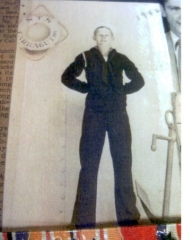Joseph M. Clennan

Joseph M. Clennan
JOSEPH
M.
CLENNAN
SOLDIER DETAILS
BIOGRAPHY
It was 67 years ago (age 17) when I joined the Navy. The US wanted its Navy recruits to be isolated from all world countries (mainly Japan) when they (or we) gathered for our training maneuvers, so they decided to start a boot camp in Farragut, Idaho in a very rugged and isolated area and built a modern training facility high in the jungle area of Idaho. Everyone assumed they would build a Navy training facility somewhere on or near ocean frontage so this jungle atmosphere was very deceiving. From boot camp, I went to Treasure Island, near San Francisco. The ship I was assigned to was launched in San Francisco. I boarded her with my fellow comrades and served as a member of the group assigned on the Captain's Bridge section. We set out to sea and sailed with the 3rd Fleet group of over 100 fighting ships of all specialties. The name of my ship was Lackawanna; it was a fleet tanker. We mainly refueled destroyers, called Destroyer Escorts (Des) and Destroyer Depth Chargers (DDs). The government named tankers after some well-known river in a state. I believe ours was in Pennsylvania. We took off from Frisco, sailing under the Golden Gate Bridge; made a hard left rudder, went between Alcatraz Island (nicknamed 'a Pile of Rocks'). It laid to our port side. We followed the coast line to San Diego and refueled there with diesel fuel and headed seaward toward 'Pearl Harbor,' in Hawaii. We took liberty or shore leave there. My inseparable buddy, Norman Clanton from Dodge City, Kansas, and I took off up the streets. Every 5th or 6th building had recreational facilities for the Fleet. We left Pearl Harbor and sailed. We crossed the Equator so I became a shellback. Incidentally, tankers never operated among the Fleet, or never moved together. Usually there were three tankers operating together. Since the enemy liked to destroy us, if possible, because of our Fleet-saving cargo, 'FUEL,' we operated separately and cruised about 12 to 15 miles behind each other. We also went on a zigzag course; reason---an enemy submarine couldn't set us up too far ahead of time because they never knew exactly where we would be. However, one time, an enemy sub lucked out on the middle tanker. She had just fueled an aircraft carrier with her load of highly explosive airplane fuel, so her empty cargo tanks had nothing but highly explosive fumes in them. She took a torpedo --- so, BOOM! --- nothing left. When the funnel of smoke cleared, nothing there but clear surface. Scared??? I was the gunner on a 40-millimeter quad machine gun. Four of us manned her so we stayed right at 'Battle Station' 24 hours a day. Another hairy incident --- we were moored alongside our mother ship, the Missouri, refueling her, when three hari-kari suicide planes showed up. One dove into our neighboring 400 mm. gun turret. One crashed the front deck where airplane fuel was stored and the third one headed for us. It missed and plunged between the two ships. We saw the pilot eject himself from the fighter and, rather that surrender, he committed 'hari-kari!' (The dummy would have been in 'hog heaven' if he had surrendered.) The weather was treacherous at times. Typhoons were common occurrences. One hit us off Guam and split us right in two. I was on the fantail so we went floating off the other direction. They took us back to Pearl Harbor and as we entered the dry dock they transferred all of us to a new tanker, the Cahaba, so back to sea we went! We rendezvoused at Guam with the 3rd Fleet. In the harbor, we were docked close together. I was assigned 'Coxswain of the Captain's Gig,' a small boat. Our captain's name was Beanblossom (good Irish name??). The writer of comic strip 'Tarzan,' Edgar Rice Burroughs, was a special guest aboard our ship. He was standing on the Captain's Bridge watching as I was attempting to board the Captain's Gig to bring it around for service. A large wave washed me overboard and I crazily fought to climb aboard.
 Eisenhower Foundation
Eisenhower Foundation
